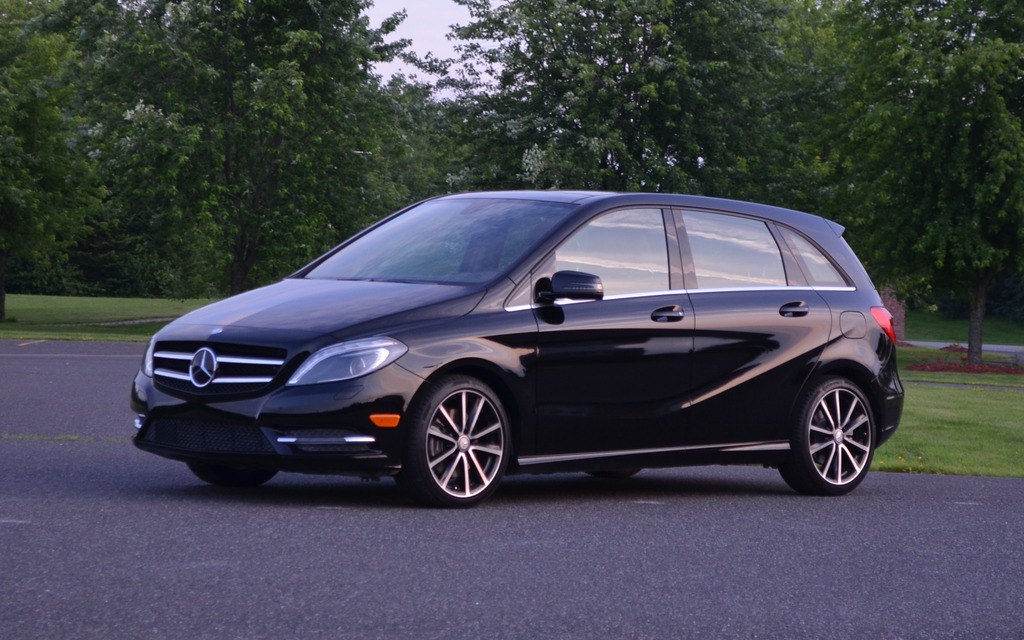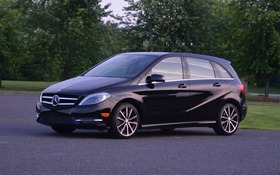Mercedes-Benz B250: Benz to the Bone

| Strong points |
|
|---|---|
| Weak points |
|
Mercedes-Benz may build some of the most opulent cars in the world, but their big money makers are actually their more affordable models. This article focusses on the B250, the brand’s smallest car in North America. It’s not the most popular though—that honour belongs to the C Class. Nonetheless, the B is a magnet for drawing new clients—mostly younger ones—into showrooms. And that itself is worth gold.
The B-Class was fully revamped two years ago. They did away with the sandwich frame that forced passengers to pick their feet up higher than usual when getting inside the car, as well as the base trim’s asthmatic engine and shoddy soundproofing. They also made the vehicle’s lines, mechanics and handling more dynamic—though admittedly that wasn’t hard to pull off.
The B250 is more petite than a Mazda5, and thus its interior is smaller, which is why there’s no third bench. That said, the designers managed to create a very spacious interior, considering the vehicle’s dimensions.
Up front, the seats are very comfortable, though some more heavy-set passengers may find them on the narrow side. Also, your left wrist had better be strong if you want to turn the knob to adjust the angle of the back of the front seats.
Technology at your fingertips?
The dashboard is classic Mercedes styling. It’s perfect for customers who like a demure look paired with efficiency and quality. If flashy is more your thing, then perhaps you should consider another car. All parts are well made except the screen that rests on top of the dashboard. Even though Mercedes-Benz is one of the world’s more technologically advanced automakers, this screen looks like a last-minute addition. It’s not even a touch screen! Some people may also find that Mercedes was a bit chintzy with the standard equipment (our B250 was devoid of a GPS, satellite radio, back-up camera and power/heated seats). If you want accessories, they are obviously going to cost you quite a bit. Power seats are only available as part of the Memory package, which costs $1,200. And that’s not even for heated ones. For those, you have to up the ante and buy the Premium package at $2,400! Don’t forget that this car’s starting price exceeds $30,000. You can definitely get a lot more bang for your buck from other manufacturers, especially Korean labels. The day that Kia and Hyundai become more prestigious, Mercedes-Benz will have to scramble to make some adjustments.
At least the B250’s trunk is huge. When the rear seat backs are up, you can fit 544 litres of cargo in back. Fold them down and you’ve got 1,500 litres of space. That’s serious business. The trunk floor is adjustable in height. This system usually works like a charm, but our test vehicle wasn’t at its most charming. It seemed that perhaps a piece was missing to hold the floor up at the highest level.
Fuel efficient, even without Eco mode
In the past, there was the B200 and the B200 Turbo. Today, the only model is the B250. Its turbocharged 2.0-litre four-cylinder engine (if you are able to figure out the nomenclature of Mercedes-Benz vehicles, call me!) delivers 208 horsepower at 5,500 rpm and 258 lb.-ft. of torque between 1,250 and 4,000 rpm. A seven-speed automatic gearbox directs all of this power to the front wheels. The transmission comes with a Sport mode that somewhat increases engine revs (at 100 km/h RPMs increase from 1,600 to 2,000 rpm) and increases engine braking to the point of a fault, actually. Since the accelerator is not as progressive as it should be, it’s hard to keep the ride smooth in Sport mode. Just remember to use it parsimoniously. There’s also an Eco mode that cuts the engine every time the car comes to a stop. In theory, that’s a good thing, but every time the engine starts up again, the whole car starts to vibrate. I had already observed this same problem on the CLS63 AMG.
During my week-long test drive, I noticed that the B250’s average fuel consumption was 8.2 L/100 km, which is just slightly more than Mercedes had promised (7.9 in the city and 5.5 on the highway). This rate, however, is still reasonable. It would be even more reasonable if the B250 didn’t require premium gas.
In a B250, you can’t really expect a sporty ride. But its road handling is solid thanks to the fact that its chassis (a modified version of the CLA-Class’ frame) is as solid as a tank. The suspension (McPherson strut in front and multi-link in back) ensures passenger comfort and does a decent job mitigating body roll on corners. The variable power steering is sharp and precise, but it doesn’t like abrupt movements, such as in a slalom. But then again, why would you do a slalom in a B250?
With its solid chassis, tremendous comfort and excellent safety level, the B250 is a Mercedes-Benz right down to the bone. And just because it’s the smallest vehicle in the family, doesn’t mean it’s not important. In fact, don’t they say that good things come in small packages?











